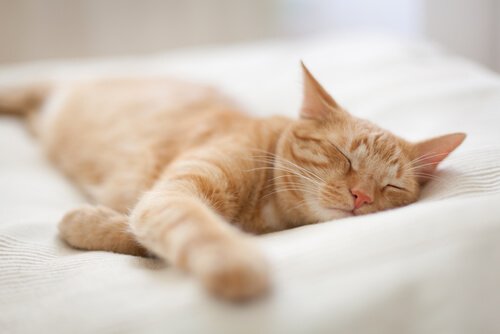Can Pets Dream?

The canine brain structure is very similar to a human’s. Dogs have the ability to remember what they have experienced throughout the day…
Pets do dream
Pets can dream just like we do. In fact, dogs can even dream just as much as we do because the human brain structure is very similar to that of a canine. Also, our brainwaves look very similar when we sleep.

But what about cats? Cats remain still during almost all stages of sleep. However, just before getting up, they arch their backs and act as if they were hunting.
Why do dogs move so much while sleeping?
You may have noticed there are times your pet is particularly active and nervous while sleeping. Well, we already know pets can dream. Now the question is: do they dream just like we do?
Dogs have two main stages of sleep : slow-wave sleep, which is the faintest type of sleep, and rapid eye movement sleep, which is the deepest type of sleep which has the most brain activity.
A dog’s sleeping brain activity is very similar to when he’s awake, which is an outcome of unconscious physical activity. The dog is unaware of his movement due to being in a deep sleep. At the same time, puppies and adult dogs tend to sleep more than most pets.

Facts about pet dreams and sleep habits
Young cats sleep about 16 hours a day and older cats can sleep up to 20 hours. Did you ever wonder why cats sleep so much? Cats would originally use most of their energy to hunt during short periods of time. Therefore, they needed to sleep in order to conserve energy.
A dog’s dream would last depending on its breed and size. Large dog breeds can dream for longer periods of time, but they don’t dream that often. Puppies may only have one minute adventures, but they may have a new one every 10 minutes.
Cats may snore, and some breeds of cats are more prone to snoring than others, like Persians and Himalayans. However, any feline can snore when lying in a position that causes its airways to be partially obstructed by the soft palate.
As the ancient proverbs says: “Let sleeping dogs lie.” When you scare a sleeping dog and wake him up from his deep sleep, he could react by biting you. It’s better to let him rest.
They are just like us
Like humans, cats love to nap during wet depressing days. This applies to both domestic and wild cats. Don’t be surprised if they yawn more and sleep longer when the forecast indicates it’s going to be rainy.
Dogs sleep in many positions depending on what stage of sleep they are in. Sometimes, when they sleep on their backs, you can see them move all four legs as if they were running on the patio or on the rooftop.
The canine brain structure is very similar to a human’s. Dogs have the ability to remember what they have experienced throughout the day…
Pets do dream
Pets can dream just like we do. In fact, dogs can even dream just as much as we do because the human brain structure is very similar to that of a canine. Also, our brainwaves look very similar when we sleep.

But what about cats? Cats remain still during almost all stages of sleep. However, just before getting up, they arch their backs and act as if they were hunting.
Why do dogs move so much while sleeping?
You may have noticed there are times your pet is particularly active and nervous while sleeping. Well, we already know pets can dream. Now the question is: do they dream just like we do?
Dogs have two main stages of sleep : slow-wave sleep, which is the faintest type of sleep, and rapid eye movement sleep, which is the deepest type of sleep which has the most brain activity.
A dog’s sleeping brain activity is very similar to when he’s awake, which is an outcome of unconscious physical activity. The dog is unaware of his movement due to being in a deep sleep. At the same time, puppies and adult dogs tend to sleep more than most pets.

Facts about pet dreams and sleep habits
Young cats sleep about 16 hours a day and older cats can sleep up to 20 hours. Did you ever wonder why cats sleep so much? Cats would originally use most of their energy to hunt during short periods of time. Therefore, they needed to sleep in order to conserve energy.
A dog’s dream would last depending on its breed and size. Large dog breeds can dream for longer periods of time, but they don’t dream that often. Puppies may only have one minute adventures, but they may have a new one every 10 minutes.
Cats may snore, and some breeds of cats are more prone to snoring than others, like Persians and Himalayans. However, any feline can snore when lying in a position that causes its airways to be partially obstructed by the soft palate.
As the ancient proverbs says: “Let sleeping dogs lie.” When you scare a sleeping dog and wake him up from his deep sleep, he could react by biting you. It’s better to let him rest.
They are just like us
Like humans, cats love to nap during wet depressing days. This applies to both domestic and wild cats. Don’t be surprised if they yawn more and sleep longer when the forecast indicates it’s going to be rainy.
Dogs sleep in many positions depending on what stage of sleep they are in. Sometimes, when they sleep on their backs, you can see them move all four legs as if they were running on the patio or on the rooftop.
This text is provided for informational purposes only and does not replace consultation with a professional. If in doubt, consult your specialist.







